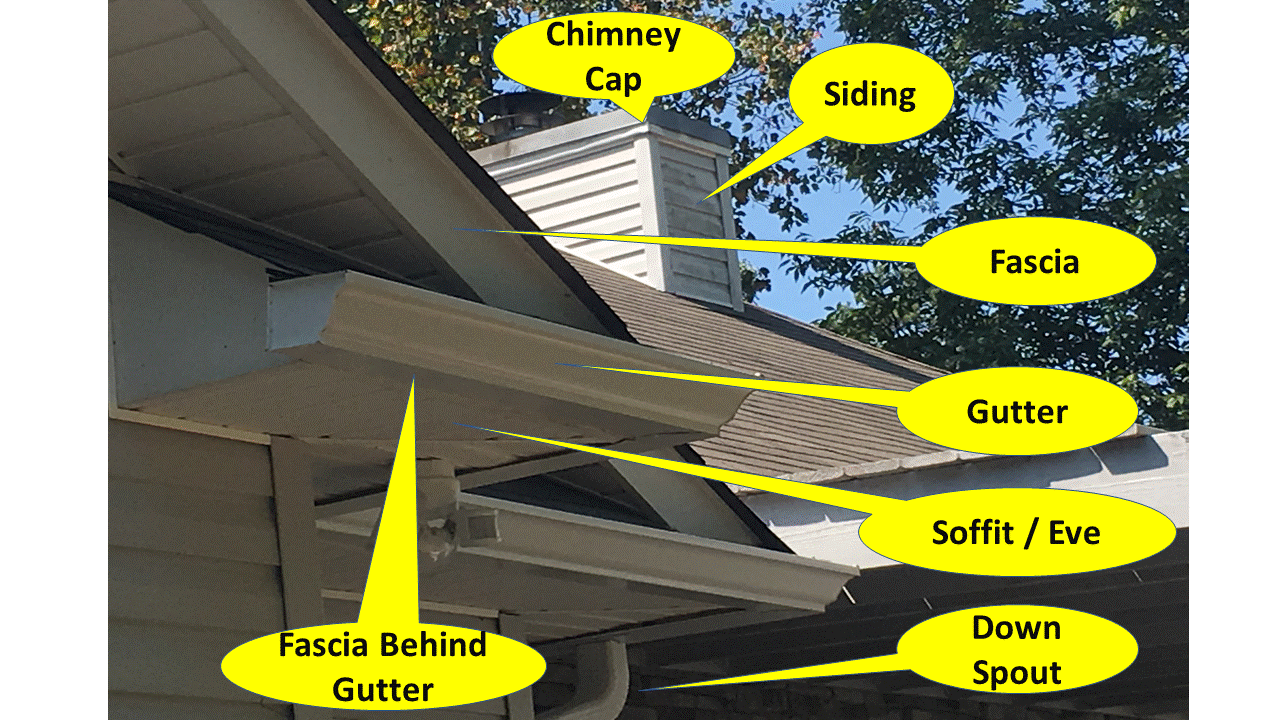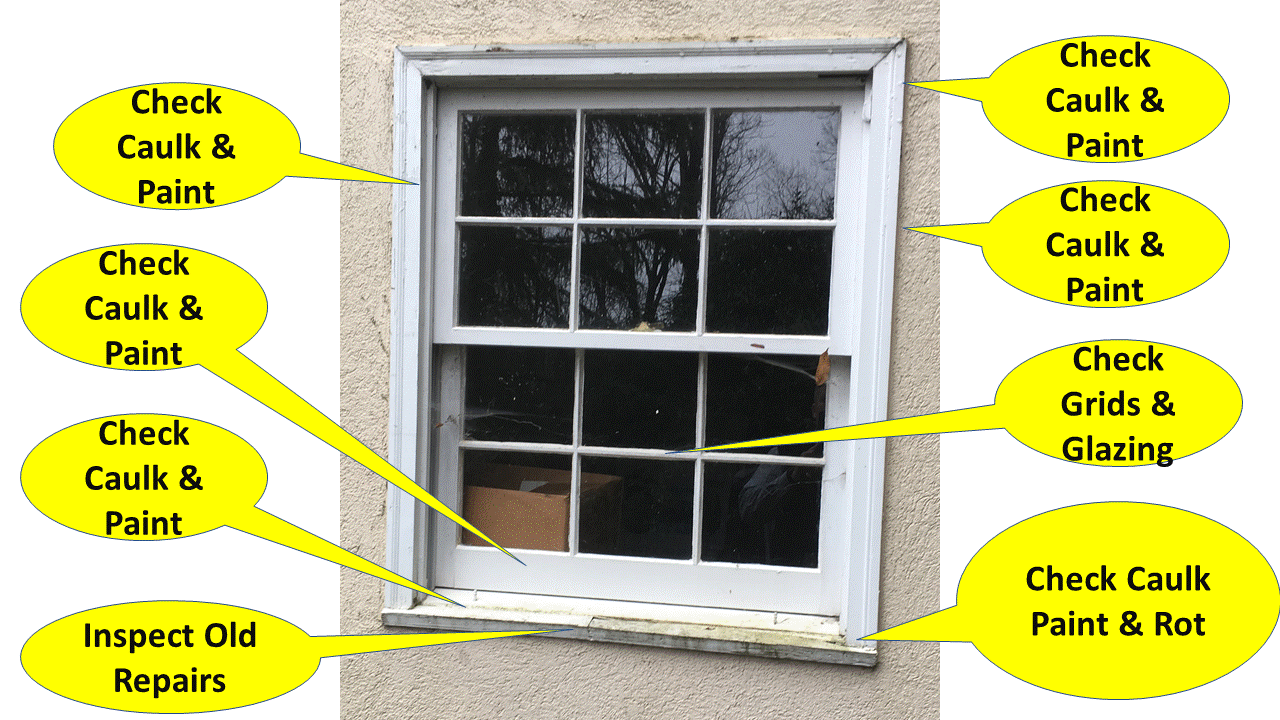
Primars Windows, Siding & Doors
"Do It Right, One Time"
Serving: North Atlanta, Milton, Alpharetta, Roswell, Johns Creek, Cumming, Dunwoody & Sandy Springs
678-683-5511
Veteran Owned & Operated
Detailed Home Inspection List
Preventive maintenance will help reduce the cost of maintaining your home. Your home may or may not have every scenario outlined below. This is a general list and may not cover every situation. You do not need a ladder or special skills to inspect your home with this list. Most of these items can be visually inspected either from the ground or from the inside looking out from your windows or in the attic. If you find an area that concerns you, call a professional to inspect the problem area and do not do anything that could be dangerous.
Before we get to the list, it is important to understand what rot really is. Rot is a symptom of another issue usually caused by water intrusion and microbes eating wood. Make sure you find the true cause of the rot before you start replacing it. Otherwise, you will be making the repair again, usually within a year or so. Wood should be firm when you press on it. If it is not, there may be an issue with rot.
We strongly recommend that you use a checklist. We have one at www.primarscontracting.com. You can use this list to walk around your home and check off each item as you go. The checklist does not have the detailed descriptions that are listed below. You can reference this article below if you have any questions about what to inspect. We encourage you to read the entire list. There are different tips that may pertain to multiple scenarios throughout the article.
Home Inspection List
We compiled a list of common problems we have run into over the years. Our goal is to help homeowners catch problem areas before they get out of control and expensive to repair. Paint is going to wear out and shingles are going to need to be replaced, but trim and framing rot can be prevented most of the time. We hope you find this list useful and "don't use epoxy."


Paint: Inspect your paint. Look for color fade, chalky, cracked, weathered, or bubbling paint. Look at your trim and windows for rot or gray cracks in the paint. If you see the presence of mildew, it may be time to paint, as well. wash your home if you only see mildew and no other signs of paint issues. Pay attention to your first-floor windows. They tend to show signs of wear before higher floors because they are not as protected by the overhang of your home.
Pay the extra cost for a higher quality paint. It will last longer, and it has a mildewcide in it that prevents microbial growth. A good paint job should last four to five years, and a great paint job will usually last seven to ten years. Remember that the labor to paint a house is the same for good paint as it is for great paint. Keep that in mind when you choose your paint.
Inspect old repairs vigorously unless they were repaired correctly by using an entire new part or piece. Bondo, epoxy and cutting in new wood are notorious for having issues a year or so after the repair.
Check your hose bibs, exhaust vents, electrical outlets, electrical connections for proper sealing and operation.





Windows: Look at the sill, trim,grids, and frame. Look for cracking in the paint, cracking in the caulk; and push on suspicious areas to see if the wood is spongy. The easiest way to inspect the sill is to open your window. If you notice rot or spongy areas, inspect the lower rail of the bottom of the sash for rot, too. While the window is open, inspect the exterior brick mold or trim where it meets the windowsill. That area is notorious for rotting.
If you have single pane wood windows, the grids and sashes should have paint, sometimes caulk, and glazing putty. If you have replacement windows, inspect the caulk between the window frame and window opening. Look at the flashing and sealant around it for wear or rust.
Caulk: Look carefully in the corners where the brick molding meets the sill and where the frame meets the sill.
Glazing: Many wood windows have grids; the panes of glass are held in place and waterproofed from a putty-like material called glazing. Look for peeling or cracked putty.
Glass: Look for cracked glass, foggy, or moldy areas in-between double-pane glass. Single-pane glass can be replaced most of the time. Double-pane glass can be replaced sometimes, but it usually requires a sash or window replacement.
Double hung & Casements: Check each window to make sure it opens and closes properly. This may seem trivial, but if you need to get out of the house in an emergency and your doors are blocked, you want your windows to work. If you have wood windows, inspect the styles and rails on each sash. This is the small frame that goes around the glass that usually moves up and down.
Paint: Look for cracked, peeling, faded, or discolored paint.
Grids: If you have grids or grills, inspect the inside and outside for peeling paint, worn exterior glazing, caulking, and mold.
Insider Tip: If you have single pane windows, look for microbial growth (mold) from condensation. Condensation can form on the inside of your windows from environmental differences between the outside air and inside air. Pay careful attention if you have plantation shutters or blinds. They tend to trap moisture leading to mold growth.
Feel for cold air leaking in the winter time.
Screens: Inspect your screens to make sure they are firmly attached to your home. During a storm, they can fly off if they are not properly secured. Inspect each screen for holes.
Click the blue button below for more window information.


Seal Failure

_JPG.jpg)
Bad Bondo Repair
Doors: Inspect each door for proper operation and make sure they are watertight. Make sure each door closes and sets itself in the door jamb correctly. Look at the flashing and sealant around the door for wear or rust. If any of your doors stick or rub, look at our repair video at www.primarscontracting.com/videos.
Jamb: Look for rot, discolored paint, mold, or cracking, especially at the bottom near the threshold. If you find rot, it can usually be replaced.
Caulk: Check the corners where the brick molding meets the threshold and all the seams.
Paint: Look for cracked, peeling, faded, or discolored paint.
Weather Stripping: Inspect the door jamb for intact weather stripping. Turn off the lights from the inside and look at the inside of the door jamb to see whether you can see light. Weather stripping is easy to replace. See our video at www.primarscontracting.com/videos.
Threshold: Look for discolored wood, mold, rot, or failed caulk. Pay attention to the lower inside corners and underneath the threshold for rot or damage.
Molding: Inspect the brick molding for rotten or discolored wood.
Locks and Hardware: Check the locks and knobs for proper operation.
Interior Flooring: Pay attention to the flooring close to the door. Look for water damage. This may be one of the first areas you notice a problem. If you have an issue with water entering your home, call a professional unless you are handy. Sometimes you can get away with just caulking the exterior, but that is usually a band-aide.


Siding: Look for loose boards, warped, missing, or wavy boards and loose nails. Look for areas small animals may be using to get inside your home. Look for bird holes. Look extremely closely to the areas that meet the roofline, doors, and windows. Look at the flashing and sealant around the siding for wear or rust.
Paint: Look for bubbling, cracked, peeling, faded, or chalky paint. Pay extra attention to the siding on the chimney, near a roof line and close to the ground.
Caulk: Inspect every joint for cracking. If you see one or two areas with cracked caulk down low, where you can see, you probably have some up high that you can’t see as well.


Stucco: Look for cracks or bulges in the stucco. Some small hairline cracks are normal, but they should be sealed and painted. Stucco likes to absorb water, and it can be difficult to tell if you need a fresh coat of paint. Look for bubbling, cracked, peeling, faded, or chalky paint. Pay extra attention where the stucco meets a roof line, doors, windows, and trim. Look at the flashing and sealant around it for wear or rust. Many times, if we find water damage, it is from a flashing issue or a window leak. We recommend an elastomeric caulk and Sherwin Williams Luxon Paint for stucco.
Paint: Look for bubbling, cracked, peeling, faded, or chalky paint.
Caulk: Look for cracking or pealing caulk.

Masonry: Inspect the material between the bricks or stone for loose or cracked mortar. Inspect the stone or bricks for cracks or loose materials. Look at the flashing for rust or cracked sealant. Look for damp areas a few days after a rainstorm.
Look for a vanilla or white build-up in the mortar, brick, or stone. That substance is called efflorescence. It appears after unwanted water enters the masonry. It can usually be removed; however, it needs attention. There could be an issue with flashing, a crack, or a leaky roof. Water is getting in, and the leak needs to be located and sealed. It could also come from water hitting the masonry on the outside surface, causing the efflorescence to build up over time. One way to remedy this problem is to spray an impregnating hydrophobic sealant to the stone, brick, or mortar.

Gable Vents or Attic Vents: Look for signs of animals. Check the paint and caulk. There should be a screen on the inside of your attic to keep animals out. Look at the paint and caulking. Any obvious damage needs to be repaired.

Trim: Pay attention to the areas where the trim joints up to other material, such as siding, brick, or roofing. Look for cracked, rotten, or discolored wood. Look for areas small animals may be using to get inside your home. Look at the flashing and sealant around it for wear or rust.
Paint: Look for bubbling, cracked, peeling, faded, or chalky paint.
Caulk: Look for cracking or peeling caulk.


Soffit and Fascia: Look for water damage, discolored wood or paint, and rot. Soffit and fascia only rot when they are exposed to water. If you find rot or discolored wood, either the roof is leaking Or the gutters are failing. Pay attention to the corners. Look for areas small animals may be using to get inside your home. Also look for water damage where the fascia meets the roof. Look at the flashing and sealant around it for wear or rust. Look for carpenter bee holes and woodpecker damage. Woodpeckers often try to eat the carpenter bees in the fascia, which causes more damage. Carpenter bees will also leave a yellow and white residue under the hole if its close to the wall.
Paint: Look for bubbling, cracked, peeling, faded, and chalky paint.
Caulk: Look for cracking or peeling caulk.

Water Damage Bad Gutters


Needs Washing & Paint

Soffit Water Damage Bad Gutters
Millwork: Millwork is a decorative add-on, usually surrounding front doors and large windows. Check these areas for damage and rot. Wooden millwork can easily hide a leak when the seams and joints fail. Be especially careful if you have a stucco home. Look at the flashing and sealant around it for wear or rust. Realy watch areas that were repaired with epoxy. Epoxy repairs repairs will usually fail. Pay attention to the areas where the bottom of the millwork is adjacent to a sill, roof line, front stoop or the ground. These are common areas to find water damage. cHECK YOUR SHUTTERS FOR DAMAGE, THEY MAY BE LOOSE TOO.

Gutters: Grab an umbrella during the next rainstorm and inspect your gutters for overflow. Pay attention to corners or end runs. Look for leaks at the seams, corners, and connections. Inspect the down spouts, and ensure they are connected to drainage pipes and are draining. Downspouts should be piped at least ten feet from the home. Look for loose sections. If you see dripping water between the gutter and the fascia (the board behind the gutter) have it checked.
Drainpipes: Ensure that the pipes drain well. Find the end of the pipes and make sure they are clear of debris. You can either inspect this during a rain shower or with a garden hose. Sometimes it is difficult to locate an end or opening. A landscaper may be able to help with this.


Garage Door: Check the operation of the door, lubricate per manufacturer’s instructions, inspect the paint, and visually inspect the spring and cable. Listen for unusual noises such as popping or cracking. Inspect the integrity of the door. Inspect the bottom seal and make sure it is sealed with the ground when the door is closed. Inspect the operation, and make sure it is level with the ground. Check the rubber boot/gasket on the bottom of the door. Check the side and top weather stripping for cracks and wear. Garage doors can be dangerous, so call a professional if you suspect any mechanical problems.
Paint: Look for bubbling, cracked, peeling, faded, or chalky paint.
Caulk: Look for cracking or peeling caulk.

Deck/Patio: Inspect the footings for loose or washed out dirt. Inspect posts for cracking, separation, or loose wood. Inspect the rails and decking for loose, cracked, or rotten boards. Inspect the stain or paint. Inspect the area where the deck attached to the home for any separation or damaged wood. Pay attention to the ends of the wood for rot or pitting. Take a step back and look for sagging or unusual dips in the decking.
If you use pressure treated wood for a repair, it cannot be painted until it is dry from the treatment process, which is usually ninety days. Often, decks are not covered under a termite bond.


Roof and Chimney: From the ground, look for loose asphalt, cracking, rolling, missing, or discolored shingles. Look at the flashing and sealant for wear or rust. Look for debris, especially near the chimney, dormers, and valleys. Look for rust from your chimney cap (the black metal piece on top of the chimney). During a rainstorm, inspect the plywood decking in your attic for wet areas. Go into your attic and look up. The plywood is called decking. Sometimes the attic is insulated, and you cannot see the decking. Look at each pipe that goes through your roof and look for dripping water. Also inspect the area where your chimney connects to your roof. Look up the flu from inside your home during a rainstorm for dripping water. Call a professional if you have any suspicious areas.


Inside Windows: Look for water damage, cracked or peeling paint, and mildew. Make sure you inspect your windows often if you have plantation shutters. Sometimes, plantation shutters hide mildew. Water can collect on the glass after a shower, cooking, or washing dishes due to atmospheric conditions outside.


Exterior Wall Inspection: From inside your home, look at each wall for water damage. Water damage is usually discolored or brown stain in the paint. Look at the ceiling and walls around the exterior walls. Pay special attention to areas with large windows. Be sure to include the basement.

Dirt/Foundation: Look around your home where the siding, brick, or stucco meets the ground. Sometimes water can wash away the dirt next to your foundation, walkways, stairs, footings, driveway, walls, and HVAC units. Look for cracking or missing materials such as bricks, siding, or decking. In older homes you may have an issue where the dirt settled near the foundation. This will keep the water from running away from your home. Sometimes this can be repaired by simply adding dirt and other times there may be a serious issue that requires a professional. Walk your property after a rainstorm to look for excessively wet areas. If the ground is still wet a few days after a rain, you may need a repair. This can be a major issue of the wet area is close to your foundation. Ensure that the water flows away from your home.


Shrubs and Trees: Make sure you trim your trees, so they do not touch your home. Sometimes it is necessary to cut them back enough so squirrels cannot jump on your roof. Shrubs should be trimmed at least twelve inches from your home. This allows moisture to drain and dry properly thereby protecting your exterior. CHECK YOUR hvac FOR ANY VEGETATIONION THAT MAY BE TOO CLOSE TO IT.


Driveway: Inspect for any cracks, excessive separation, pitting, rust, or pulverized concrete. Look at the sealant for wear. wash as needed.


This guide is for informational purposes only. Primars Contracting does not guarantee or warranty the information contained in this guide. Primars contracting is not liable for damage to your home from this guide, wear and tear, lack of maintenance or acts of god.